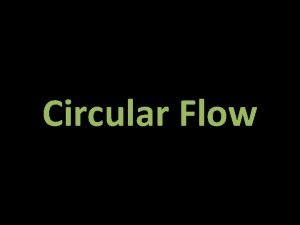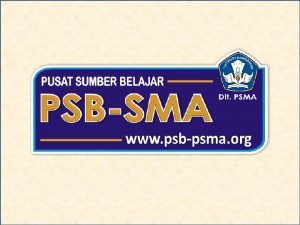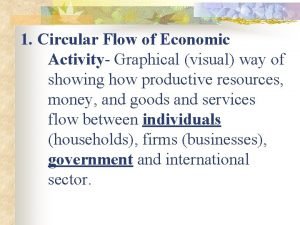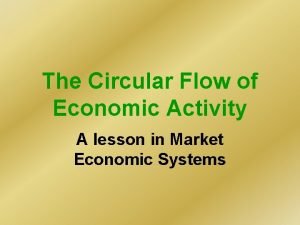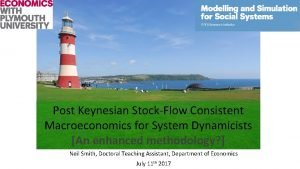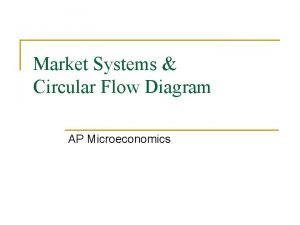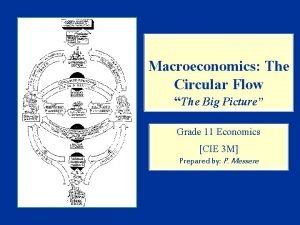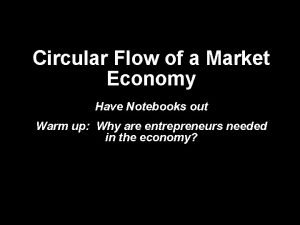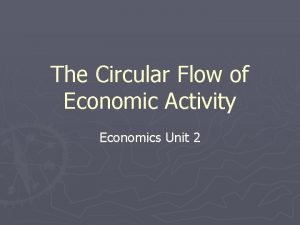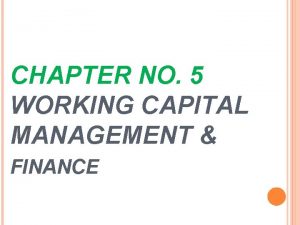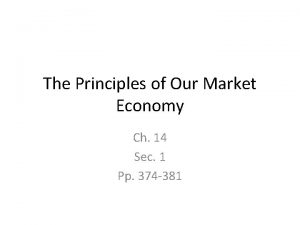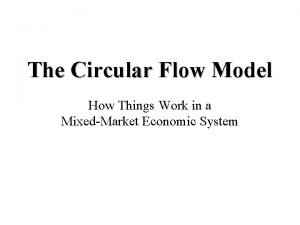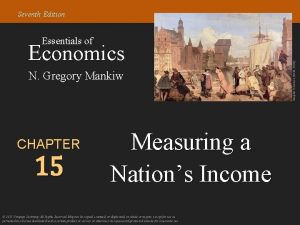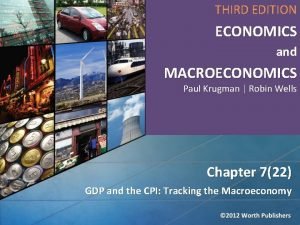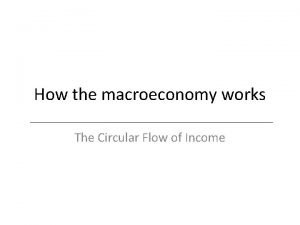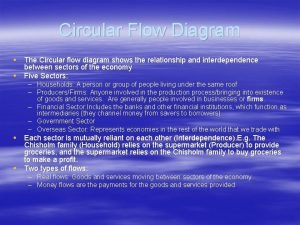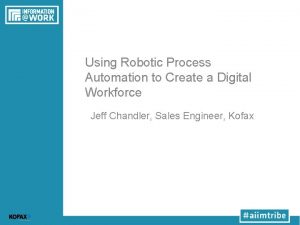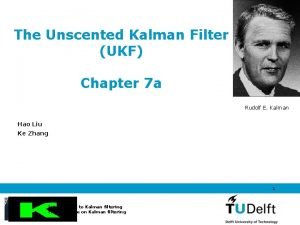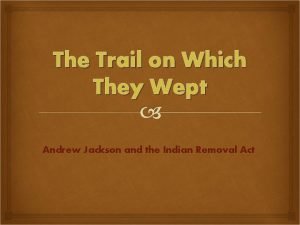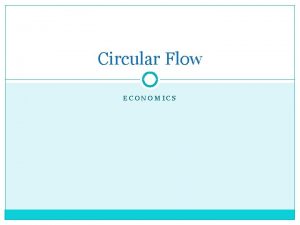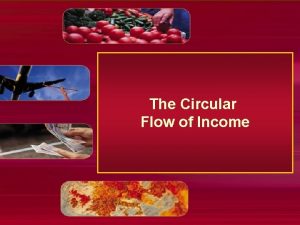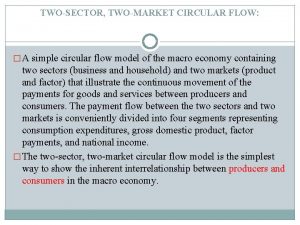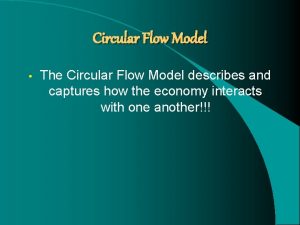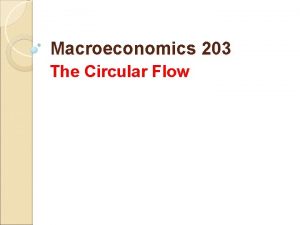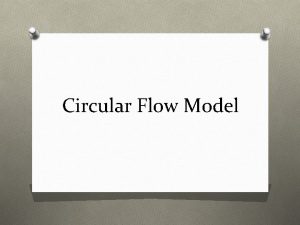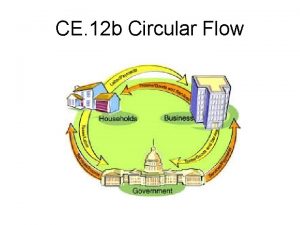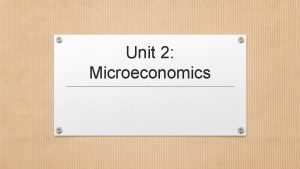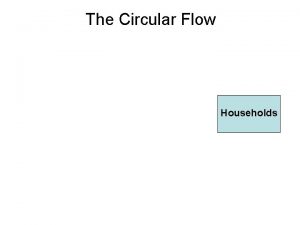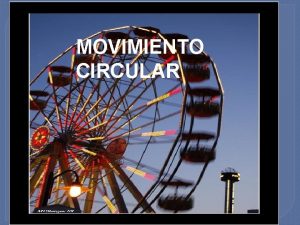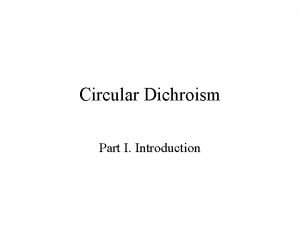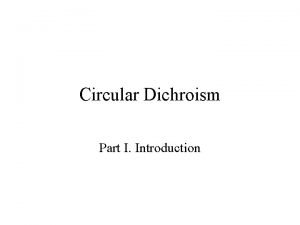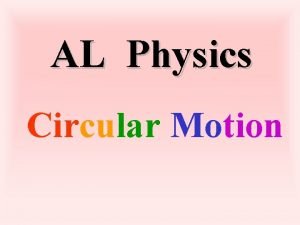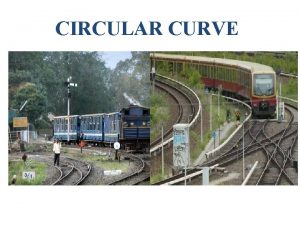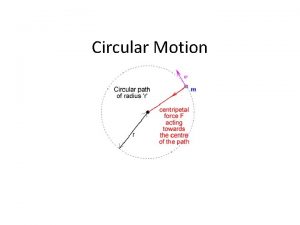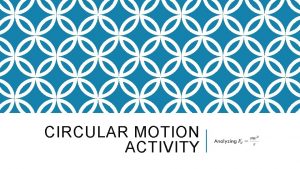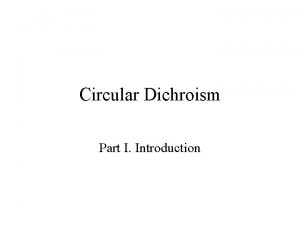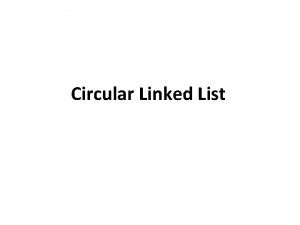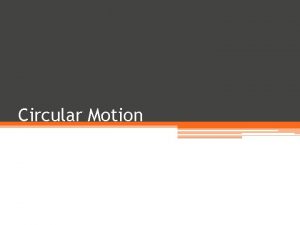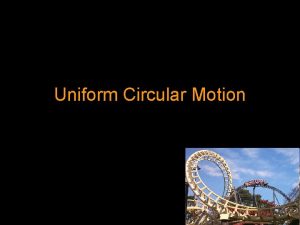The Money Trail The Circular Flow of Money











































- Slides: 43

The Money Trail

The Circular Flow of Money Model

The Users of Money Consumers Spend Producers Invest

Government Roles Treasury Department Prints Money Central Banks- Plan Monetary Policy

Banks “The Keepers of the Money” • • • Checkable Deposits Savings (Leakages) Loans (Injections)

If connectivity has been an issue please contact me so that I may contact the Technology Department. If there are questions on how to submit the assignments of the assignments in general please email me

The Financial Sector of Macro • • Purpose Components How it works Module #22

Where do people keep their savings? Banks take accumulated savings, (leakages)which are liquid, and turn those financial (paper based) assets and turns them into physical, more tangible assets.

What do banks do with accumulated savings? Loans (inject in the form of investments)

Purposes of Financial Markets • • • Reduce Risks to Investments Reduce Transaction Costs Provide Liquidity for Physical Investment

Financial Markets Include • • Bank Deposits Loans Stocks Bonds

Banking in the Macroeconomy Types of Banks • Commercial banks • Credit Unions • Savings and Loans • Investment Banks Roles of Banks • Lending • Savings • Electronic Transactions • Promoting Economic Activity

Present Value of Money: Module #24 A long lost relative offers you either $10, 000 today or $10, 500 one year from now. At what annual rate of interest would you be indifferent to the choice? Let Khan Academy show you how to do the math.

So………… (Post in Comments) What is the role of interest in the financial market? -------Incentive for saving and lending What is the value of money? • No Intrinsic Value

Types of Money • • • M 1 Fiat Currency Specie M 2 Near Money

Purposes of Money • Medium of Exchange • Unit of Accounting • Store of Value

Does American Currency Meet All Three Criteria? https: //www. federalreserve. gov/faqs/how-long-is-the-life-span-of-us-paper-money. htm

Story of Slim and the Wild West The Creation of the Banking https: //www. youtube. com/embed/Z_f. OKk 5 Zk. A? rel=0 http: //reffonomics. com/Recollectionsof. Pine. Gulch. html

T- Accounts Assets Liabilities • Required Reserves • Loans • Excess Reserves • Checkable Demand Deposits

The Money Multiplier: Growing Money • Money Multiplier= 1/ required reserve ratio • • • Actual Change in Money Supply = money multiplier * change in total reserves Some criticize the FED for creating a “Money Bubble” But individual banks decide whether to lend excess reserves Within “monetarism” philosophy there is debate

Old AP Multiple Choice Question Assets • Reserves $200, 000 – Required – Excess $80, 000 $20, 000 – Loans $200, 000 Liabilities • Checkable $400, 000 Deposits • What happens to the required reserves, excess reserves and money supply if $100, 000 is withdrawn from the bank?

2012 AP Macroeconomics FRQ #2 The following is a simplified balance sheet for Mi Tierra Bank in the United States. Mi Tierra Bank Assets Required Reserves Excess Reserves Loans Liabilities $10, 000 $5, 000 $85, 000 Demand Deposits Owner’s Equity $100, 000 $0 (a) What is the reserve requirement? (b) Assume that Luis withdraws $5, 000 in cash from his checking account at Mi Tierra Bank. (i) By how much will Mi Tierra Bank’s reserves change based on Luis’ withdrawal? (ii) What is the initial effect of the withdrawal on the M 1 measure of money supply? Explain. (iii) As a result of the withdrawal, what is the new value of excess reserves on the balance sheet of Mi Tierra Bank based on the reserve requirement from part (a) ? (c) Assume that the next day John withdraws from Mi Tierra Bank an amount that exceeds the bank’s excess reserves. Assuming that no loans are called in, how can Mi Tierra Bank cover its required reserves? https: //secure-media. collegeboard. org/apc/ap 12_frq_macroeconomics. pdf

2016 AP Macroeconomics FRQ #2 Assets Reserves Loans $200 $1, 800 Liabilities Demand Deposits Equity (Net Worth) $2, 000 $0 Assume that the required reserve ratio is 10% a. What is the dollar value of new loans that this bank could make? Explain b. Mr. Smith deposits $100 of cash in a demand deposit account at that bank. Calculate the maximum amount of new loans that bank can make. c. As a result of Mr. Smith’s cash deposit, calculate the maximum change over time in each of the following in the banking system. i. Loans ii. Demand Deposits d. As a result of Mr. Smith’s $100 cash deposit, calculate the maximum change over time in the money supply. e. Provide one reason why the actual change in the money supply can be smaller than the maximum change you identified in part (d).

When banks can’t cover required reserves…. • they can borrow from other banks and pay the federal funds rate • they can borrow from the FED itself and pay the discount rate • if the bank fails, customers have their first $250, 000 insured by the FDIC

America’s Central Bank

Regional Federal Reserve Banks

Purpose of “The FED” • • The Nation’s Central Bank Control Money Supply Regulate the Economy Through Monetary Policy The Government’s Banker Holds Reserves for Banking Institutions Intervene in Foreign Exchange Rate Market Lender of Last Resort Check Clearing Process

Monetary Tools • Methods used to implement monetary policy • Required Reserve Ratio • Changing the Discount Rate • Buying/Selling Government Securities Expansionary Policy Contractionary Policy

The FOMC • Board of Governors + 5 Reserve Bank Presidents • If the “FED” buys government securities from banks then a banks total reserves increase allowing the bank to loan out more money (Expansionary) • If the “FED” sells government securities from banks then a banks total reserves decrease forcing the bank to loan out less money (Contractionary)

The Discount Rate • • The most transparent of FED actions The FED acting as a lender of last resort Difference between discount and federal funds rate Rate agreed upon every 6 weeks by the board of governors led by Chairman Jerome Powell

What does the Money Market Illustrate?

Determinants of Money Demand • • • Change in efficiency of payments technologies Change in liquidity of alternative assets Change in risk Change in wealth Change in real income Change in expected inflation

Shifts in the Money Supply

Impact of Expansionary Monetary Policy on the Money Market

The Bond Market

The Other Bond Market • As interest rates increase, the price of bonds decreases. • As interest rates decrease, the price of bonds increases.

For a Deeper Dive 25. 1 The Bond and Foreign Exchange Markets – Principles of Economics A Bond is physical piece of paper with a set value. If the price of bonds deceases, the interest rates must increase to maintain its value and vice-versa.

The Credit Market

The Crowding Out Effect

Does increased government deficit spending always “crowd out” private investment? Recessionary Gap Gov’t Borrowing could close the gap and not crowd out private investment. Long Run Equilibrium Gov’t borrowing would raise real interest rates and decrease the level of private investment spending.

Different Opinions

Equation of Exchange and the Quantity Theory • MV= PQ • M= money held by non banking public • V= velocity of money- # of times money unit is spent see www. wheresgeorge. com • P= price level • Y= real gdp

Monetary Policy Websites • • http: //www. federalreserveeducation. org/FRED/ (History and Structure- plus games!) http: //www. economicadventure. org/index. cfm (Created by Boston Federal Reserve Bank) http: //www. ny. frb. org/education/fedchal. html (The Fed Challenge) http: //www. frbsf. org/publications/federalreserve/monetar y/index. html • (The Fed explains monetary tools and policy) • Plenty of ACDC Leadership Videos
 Money money money team
Money money money team Element of hair
Element of hair Circular flow of income
Circular flow of income Calculate gdp circular flow diagram
Calculate gdp circular flow diagram Circular diagram flow
Circular diagram flow Circular flow of economic activity
Circular flow of economic activity Define circular flow of economic activity
Define circular flow of economic activity Circular flow matrix
Circular flow matrix Circulair flow marketing
Circulair flow marketing Grade 9 circular flow diagram
Grade 9 circular flow diagram Circular flow model worksheet
Circular flow model worksheet Define circular flow of economic activity
Define circular flow of economic activity Net working capital cash
Net working capital cash Market economy principles
Market economy principles Circular flow diagram
Circular flow diagram Households and firms circular flow model
Households and firms circular flow model Expanded circular flow diagram
Expanded circular flow diagram Circular flow of income injections and withdrawals
Circular flow of income injections and withdrawals A circular flow diagram shows
A circular flow diagram shows The great gatsby historical background
The great gatsby historical background Money smart money match
Money smart money match Money on money multiple
Money on money multiple Context of the great gatsby
Context of the great gatsby The great gatsby historical context
The great gatsby historical context Reservoir system
Reservoir system Venturi mask
Venturi mask High flow versus low flow oxygen
High flow versus low flow oxygen Laminar flow definition
Laminar flow definition Internal vs external flow
Internal vs external flow Flow of energy vs flow of matter
Flow of energy vs flow of matter Flow of energy vs flow of matter
Flow of energy vs flow of matter Dfd to structure chart
Dfd to structure chart Transform flow and transaction flow
Transform flow and transaction flow Irrotational flow means *
Irrotational flow means * Internal flow and external flow
Internal flow and external flow Data flow vs control flow
Data flow vs control flow Flow chart of cheese production
Flow chart of cheese production Control flow and data flow computers
Control flow and data flow computers Transaction flow testing
Transaction flow testing Trail kofax kapow
Trail kofax kapow Trail of tears worksheets
Trail of tears worksheets Quotes about the trail of tears
Quotes about the trail of tears Lrkf
Lrkf Andrew jackson trail of tears map
Andrew jackson trail of tears map


